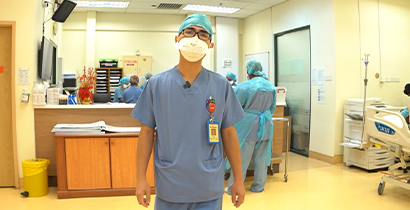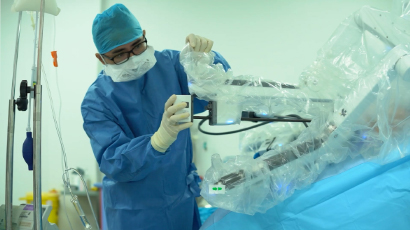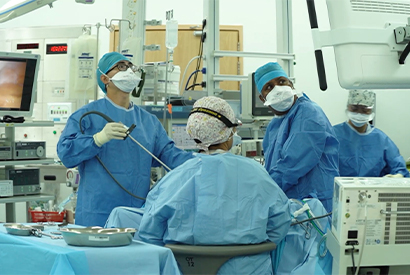A day in the life of Richel Emong, The Story of an Operation Theatre Robotic Nurse
21 May 2022
How long have you been working as a nurse?
This year would be my 12th year since I’ve been a nurse. I got my nursing qualification & certification in 2010, and joined Sunway Medical Centre (SMC) in August. I was placed in the Central Sterile Supply Department (CSSD), where I learned the sterilisation processes and familiarised myself with the variety of instruments available in the hospital. In 2013, I had the opportunity to transfer to the Operation Theatre department, and this is where I have been since.

What is your training pathway for Robotic Surgery?
I was lucky to be chosen to train in robotic surgery when the hospital brought in the da vinci Si robotic system in September 2016. At first, I attended the in-house training where I learned to set up the robotic systems such as system connection, draping (keeping the robot sterile), camera calibration, robot docking, patient positioning and troubleshooting for any unexpected circumstances or errors during surgeries. After that, I did an online exam to get certified to assist in robotic surgeries.
In July 2017, Sunway Medical Centre sent me to the Robotic Training Centre in South Korea to train and get accredited as a bed-side assistant in robotic surgery. There, I spent 3 days assisting surgeons in the animal lab and attended case observations in robotic colorectal surgery. After completing my training, I started assisting in robotic surgery and was very proud have assisted in Sunway Medical Centre’s 1st colorectal robotic surgery.

What is your daily routine/task in Robotic surgery?
As robotic nurse, we will make sure the robotic surgical system and all other equipments are ready: system start-up is running, draping (keeping the robot sterile), camera calibration, then a final check to make sure all the necessary preparations are done before the patient enters the theater for surgery. We will position the patient according to surgery needed, then assist as a bed-side assistant or instrument nurse. Once the surgery is completed, we will record the robotic instrument’s usage, cleaning and do an inventory for robotic related stock.
What make you different of being a robotic nurse?
Everybody can learn robotic surgery, but one must be willing to commit and withstand long surgery hours because most of the cases listed under robotics are complex cases such as prostate removal surgery. Despite the long hours, we have more opportunities to pick up advance surgical skillsets such as retraction, suction, stapling, port placement, etc. Upon every successful surgery, we come out feeling proud to have been a part of the team and such experience is very valuable in our nursing career.
What are the challenges that you face as robotic nurse?
The long hours in surgery. We will be tired and exhausted especially when there are 2 robotic surgeries scheduled back-to-back. We also feel stressed troubleshooting when there are incidents such as the robotic arm clashing due to inappropriate port placement, surgical complexity involving different patient’s body sizes, or dense adhesion because of previous surgeries, and high-risk bleeding. It’s also hard to manage patient expectation with post-op patient conditions such as skin integrity and pressure marks.
What do you most enjoy about being a robotic nurse?
We feel good because we are able to help and are “needed” in surgery. With such a recognition, I gained confidence as a skilled nurse who is able to maneuver high tech surgery systems.
Besides, I also realized that I am able to increase the dominance and ability of my non-dominant left hand and train myself to be somewhat ambidextrous, which helps a lot in general for surgeries.
What was your satisfaction moment being a robotic nurse?
Being more of value as a nurse because I possess an extra skillset as a robotic nurse which are a very special experience to have.
Better patient outcomes. Getting to know that the surgeries you assisted makes good and faster recovery time for patients and they were able to get discharged earlier then expected without any surgery complications.
To be able to introduce and successfully train newcomer nurses of the beauty of Robotic surgery.







